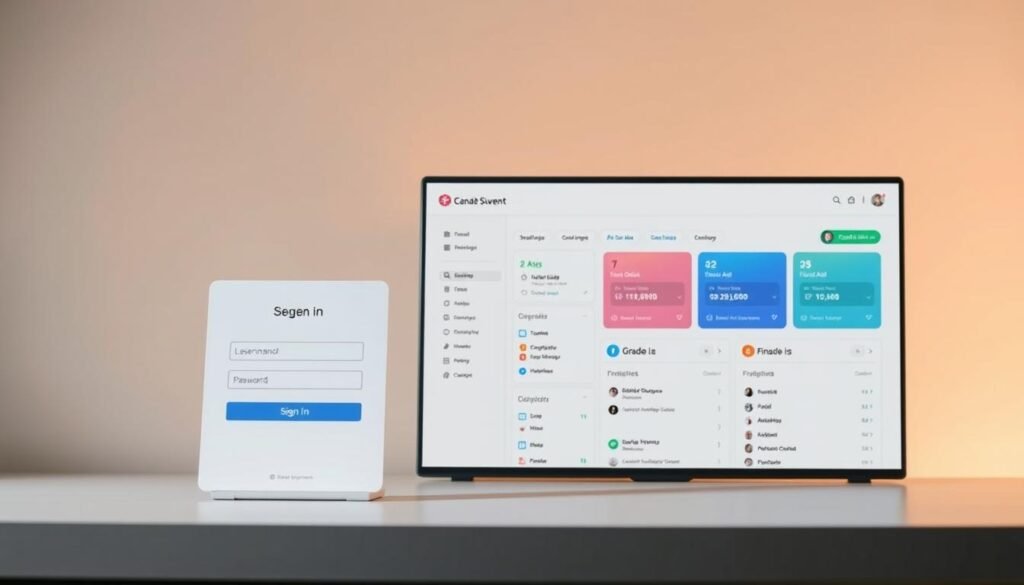
Top Investing Tips for International Students Canada

Welcome. You’ve just arrived, found a bank and opened an account, and now you wonder how your money can work while you study.
Picture this: on a frosty morning in Toronto, Maya put two loonies into a jar and labelled it "future." She set a small savings goal and watched it grow. That habit made her feel steady when classes got busy.
You’ll get clear information and simple steps to set up an account, build an investment plan and keep savings steady over time. This section gives friendly context so you know what comes next.
Note: this article is for information only and not financial, tax or investment advice. Interest rates and rules can change. Consult a professional for guidance tailored to your needs.
- Why start now: a beginner’s guide tailored for students in Canada
- Understanding your goals before you invest
- Setting up your foundation: student bank account and savings account
- Your Social Insurance Number: when you need a SIN to invest
- Accounts to invest through: TFSA, RRSP, and non-registered
- Ways to invest in Canada: do-it-yourself, robo-advisors, or advisors
- Investment options for beginners: GICs, bonds, ETFs, mutual funds, stocks
- Investing tips for international students Canada
- How to get started step by step
- Costs matter: fees, interest rates and account conditions
- Credit building while you invest: using a credit card wisely
- Risk, returns, and timelines
- Tools and services you can use
- Tax basics for students in Canada
- Protecting your money: safety, coverage and third-party considerations
- Before you invest: information purposes only and tailored advice
- Your next move: build your plan, stay disciplined, review over time
Why start now: a beginner’s guide tailored for students in Canada
When you open an account now, compound growth works in your favour over the long run. Small, regular deposits can grow across years, so even modest amounts matter. Starting early gives you more time to learn and build consistent habits.

Set a simple plan and keep it practical. Automate contributions to make saving automatic. Use a written goal to focus on an emergency cushion or a longer-term milestone.
- Starting as a student lets compound returns act over more time, even with small sums.
- Open an account online with your bank or try a robo-advisor if you want a hands-off approach.
- You can also open a direct investing account to manage products yourself, or book a meeting with an advisor for personalised advice.
Keep fees and conditions in mind from day one. With basic information about accounts and products, you’ll pick options that match what you want to achieve and grow your confidence step by step.
Understanding your goals before you invest
Start with a simple list: what you need money for and when you'll need it. This helps you separate short-term needs from long-term plans and makes choosing the right account clearer.
Short-term goals usually cover one to five years. Keep risk low so your savings are there when tuition, travel or an emergency hits. Attach a dollar amount and a target date to each short-term goal.
Long-term goals span five years or more. You can accept more volatility because time lets you recover from market drops. Long-term plans might include a first home or retirement and often use growth-focused products.
- List needs and timing: emergency fund, tuition, travel, first home, retirement.
- Match product risk to your time horizon—safer options for short-term, diversified growth for longer-term goals.
- Set a clear amount and a contribution plan. Prioritise an emergency fund first, then add monthly sums to other targets.
- Review goals each term or at least once a year and adjust your account choices and contributions.
If you’re unsure, seek professional advice to balance trade-offs and get details tailored to your situation. Keep the plan simple and document progress so you stay consistent.

Setting up your foundation: student bank account and savings account
Open an account that balances low costs with useful services like Interac e-Transfer and mobile access. A good student bank account reduces monthly fees and keeps daily money simple to manage.
Choosing a student bank with low fees and access to services
Look for a student bank offering fee waivers, clear limits and easy support. You may be eligible for a student chequing account if you’re enrolled full-time and can show proof of enrolment. Extra charges can apply for shared ABM use, cross-border debit or services outside the package. Conditions and features may change without notice, so check the details when you open the account.

How a chequing account and savings account work together
Use a chequing account for daily bills and a savings account for short-term goals and an emergency cushion.
- Start with a student bank account to minimise fees and get Interac and debit access.
- Link chequing and savings accounts to automate transfers on payday.
- Compare packages: monthly fees, transaction limits, international transfer options and digital features.
- Set alerts, keep a small buffer in chequing and review your package each year.
Keep the facts and paperwork handy. Confirm eligibility, required proof and which services carry extra charges so you avoid surprise fees and have clear information when you need help.
A Social Insurance Number is a key piece of ID you will need before opening certain registered accounts. A valid SIN allows banks and account providers to report investment income for tax purposes and issue official slips.
As a student, check which account types need your SIN and keep records that match your ID.
SIN basics and tax reporting
You typically need a Social Insurance Number to open registered accounts and to ensure income is reported correctly to tax authorities.
Access and protecting your information
Share your insurance number only with trusted services and confirm any request directly with your bank or the account provider.
- Avoid sending your SIN by unsecured email.
- Store the document separately from your wallet and limit who sees it.
- If you suspect exposure, contact the bank and authorities without delay.
| Need | When required | Action |
|---|---|---|
| Registered account | Opening TFSA/RRSP-style accounts | Provide SIN and ID |
| Tax slips | When you earn interest or gains | Keep contact details current |
| Security | Protecting personal details | Verify requests; seek professional advice if unsure |
Accounts to invest through: TFSA, RRSP, and non-registered
Picking an account shapes how your savings grow and when you can use them. Each option changes the way gains are taxed, who can open it and how much room you have to contribute.
TFSA — tax-free growth and eligibility
A Tax-Free Savings Account (TFSA) is simple to use if you meet the rules: you must be 18 or older, a resident of Canada and have a valid Social Insurance Number.
Growth and withdrawals are tax-free, which makes the TFSA powerful when you want flexible, tax-free access to gains.
RRSP — tax deferral and contribution room
An RRSP reduces your taxable income when you contribute. Contribution room builds after you start work generally 18% of the previous year’s earned income and unused room carries forward across years.
If you expect higher income later, contributions now can cut tax. RRSP rules also allow eligible first-home programs to withdraw funds under set details.
Non-registered flexibility with tax consequences
Non-registered accounts have no contribution limits and offer full flexibility.
However, gains, interest and dividends are taxable each year, so record-keeping matters to report income correctly.
"Choose an account that matches your time horizon and whether you need tax-free access or tax deferral."
- Keep clear records of contributions and withdrawals to avoid penalties.
- Confirm age-of-majority and ID before opening any account.
- Review fees, product availability and account conditions in the provider documents.
| Account type | Key benefit | When to use |
|---|---|---|
| TFSA | Tax-free growth and withdrawals | Short or long-term savings with flexible access |
| RRSP | Tax deferral and lower taxable income now | If you have earned income and plan long-term or first-home purchase |
| Non-registered | No limits and high flexibility | When you need access or have maxed registered room; expect taxable gains |
If you need help understanding tax impacts, seek a qualified professional who can explain how each account fits your goals and provide tailored information and details before you start an investment plan.
Ways to invest in Canada: do-it-yourself, robo-advisors, or advisors
Decide whether you want full control, a largely automatic solution, or tailored guidance from a wealth team at your bank.
Do-it-yourself (DIY) platforms give you hands-on control. Order-execution-only services such as Scotia iTRADE let you place trades and use research tools, but they do not give recommendations. That means you are responsible for decisions and outcomes.
DIY with online brokerages and practice accounts
DIY brokerages offer low-level commission plans, simulators and practice accounts to build confidence. Some student banking packages may include commission waivers on eligible trades—check eligibility, exclusions and account status for details.
Automated portfolios via robo-advisors
Robo-advisors automate portfolio construction and rebalancing based on your risk profile. They save time, provide low-touch management and often include educational resources and simulators.
Advice-based investing through bank branches or wealth teams
If you prefer personal support, you can work with advisors at a branch or wealth team. RBC offers multiple options: RBC Direct Investing (DIY), RBC InvestEase (automated) and RBC Wealth Management (advice-based). Ask about fees, account types and available products before you commit.
"Compare platforms on fees, account types, mobile experience and customer service options such as phone support."
- Understand that order-execution-only platforms do not provide recommendations.
- Compare fees, accounts, products and mobile tools before you choose a service.
- Keep accounts in good standing to retain any platform-specific benefits.
- Start small or use a practice environment to learn without risking much capital.
| Approach | Best when | Key consideration |
|---|---|---|
| DIY brokerages | You want control and learning | Research time; no advice provided |
| Robo-advisors | You prefer low-maintenance accounts | Automated rebalancing; set fees |
| Advisor service | You want tailored planning | Higher fees; personalised guidance |
For a practical starting point, read a newcomer's guide that explains account types and services in more detail.
Investment options for beginners: GICs, bonds, ETFs, mutual funds, stocks
Understand the main product categories so you can match choices to your goals and timeline. Each option has different risk, fees and potential returns.
GICs (guaranteed investment certificates) protect your principal and may be eligible for CDIC coverage up to $100,000 per eligible deposit category when issued by a CDIC member. Fixed-rate GICs give predictable interest and a known term.
Bonds pay interest when you lend money to governments or municipalities. They can add steady income and reduce overall portfolio volatility.
ETFs and mutual funds pool many securities. ETFs often track indexes and tend to cost less. Mutual funds give professional management. Neither is guaranteed; values change and past performance may not repeat. Read the prospectus for full details.
Stocks can offer higher long-term returns but come with greater volatility. Use them with a longer horizon and a clear plan.
- Build a core of diversified funds (ETFs or mutual funds) and add GICs or bonds for stability.
- Review risks, fees, and how each product fits your account and goals before you buy.
- Use registered accounts when appropriate to improve after-tax outcomes.
| Product | Primary benefit | Best use |
|---|---|---|
| GIC | Guaranteed principal, fixed rate | Short-term savings |
| ETF / Mutual Fund | Diversification, convenience | Core portfolio building |
| Stocks | Growth potential | Long-term growth |
Investing tips for international students Canada
A simple, repeatable habit can turn tiny monthly amounts into meaningful savings over many years. Set a pre-authorized contribution so money moves automatically from your account each month.
Example: if you put $50 a month into a diversified fund and it averaged a hypothetical 5% annual return, your balance can grow significantly over 15 years (excluding fees and taxes). The key is time in the market and steady contributions.
Start small and stay consistent
Begin with an amount you can afford and automate it. One small move each month builds momentum and reduces decision fatigue.
Diversify and protect your plan
Diversify across asset types to smooth returns and lower single-holding risk. Keep a separate emergency fund so you don’t sell during a market drop.
- Set a clear plan for the monthly amount based on your student budget.
- Focus on time in the market rather than timing the market.
- Increase contributions gradually small annual raises add up over years.
- Use low-cost, diversified funds as a core and try practice accounts before scaling up.
- Review your allocation at least once a year and track progress to stay motivated.
"Automate, diversify and review simple steps that keep your plan on track while you study."
| Action | Why it helps | Practical step |
|---|---|---|
| Automate monthly contributions | Reduces missed deposits; builds habit | Set a pre-authorized transfer of a set amount each month |
| Diversify holdings | Smooths returns; lowers risk | Use ETFs or mixed funds across equities and bonds |
| Keep emergency savings separate | Avoid forced sales in downturns | Hold 3 months of expenses in a simple savings account |
How to get started step by step
Start by lining up the accounts and documents you need so you can move money without friction.
Open your bank account online or book a meeting by phone or in person. Choose an investment account that matches your goals and link the two accounts to make transfers easy.
Open your bank account and link your investment account
Open a bank account if you haven’t already, then select the account type you want to use for saving and growth.
Link the accounts and set a regular transfer on a fixed date each month so contributions happen automatically.
Verify eligibility, age of majority, and identification
Confirm age-of-majority rules and residency requirements before you apply. Gather ID, proof of enrolment and any documents your bank or service asks for.
Automate contributions to stay consistent
Set a pre-authorized contribution (PAC) for a manageable amount that fits your monthly budget. Adjust the amount each term as your income or costs change.
- Choose a platform: DIY, robo-advisor or advisor service based on the support you want.
- Enable two-factor authentication and app alerts to protect access and monitor activity.
- Keep a simple checklist: open, link, fund, invest and review.
| Step | Why it matters | Quick action |
|---|---|---|
| Open bank account | Gives everyday access and transfer ability | Apply online or visit a branch |
| Link accounts | Simplifies moves between accounts | Connect via online banking or by signing forms |
| Automate PAC | Keeps contributions consistent | Set date and amount aligned with your pay cycle |
| Secure access | Protects funds and login details | Enable 2FA and record recovery methods securely |
Costs matter: fees, interest rates and account conditions
Small costs add up over time, so understanding fees will protect your balance. Look beyond advertised returns to see what you actually keep. Read product documents and account terms before you sign up.
Commissions, MERs and platform charges directly reduce your returns. Mutual funds and ETFs carry management fees and operating expenses. Trading commissions may apply unless a student package waives them, subject to eligibility and accounts in good standing.
- Compare platform fees like trading commissions and annual account fees.
- Understand fund costs: MERs, trading spreads and any currency conversion charges.
- Verify account conditions such as minimum balances, inactivity fees and transfer charges.
Interest rates and market conditions can change
Watch how interest rates affect savings and fixed-income returns, and how a changing rate environment alters borrowing costs.
Information including interest rates, market conditions and tax rules is subject change and can change without notice. Check updates periodically and keep records of charges so you can adjust if conditions shift.
| Cost type | What to watch | Why it matters | Quick action |
|---|---|---|---|
| Trading commissions | Per-trade fees or commission schedules | High trading costs reduce short-term gains | Compare brokers; confirm student waivers |
| Fund MERs & expenses | Annual percentage charged to funds | Lower MERs often improve long-term returns | Pick low-cost ETFs or index funds when suitable |
| Account conditions | Minimums, inactivity fees, transfer charges | Unexpected fees erode balances | Read terms and keep accounts in good standing |
| Interest rates & savings | Promotional vs. posted rates | Rates drive savings yield and borrowing cost | Track rate changes and shop for better offers |
Read each prospectus and ask for a breakdown if fees seem unclear. For basic guidance on saving accounts, see our savings account guide.
Credit building while you invest: using a credit card wisely
Using a card the right way helps your credit history grow without adding costly debt. A student-friendly credit card can boost your profile when you pay on time and keep balances low.
Pay on time and avoid high-interest balances
Always pay the full balance each month if you can. That prevents high interest charges and stops fees from eating into your budget.
Some student banking packages offer a first-year annual fee rebate on select credit cards, subject to approval and eligibility. Features and fees can change, so check the offer details before you apply.
Practical habits that build credit
- Use a credit card for small, planned purchases and pay on the due date to build a positive record.
- Keep utilisation low; a low ratio supports a stronger credit score over time.
- Set up automatic payments from your account so you never miss a payment date.
- Review your statement each month to spot fees, errors or unexpected charges.
- Track the interest rate and promotional periods so you’re not surprised later.
- Check if your bank gives TransUnion access and alerts without impacting your score.
- Reassess your card each year to ensure it still fits your plan and budget.
Risk, returns, and timelines
How much risk you take should match how many years you plan to keep money invested.
Short time horizons deserve safer choices so you avoid selling at a loss when you need cash.
Longer horizons typically five years or more can accept more volatility because markets often recover given time. Diversified funds can help balance growth potential and risk while you wait.
Volatility basics and aligning risk with your years to invest
Match risk to your timeline. The more years you have, the more short-term swings you can usually tolerate. Higher expected returns tend to come with bigger day-to-day price moves.
Speculative assets caution: crypto and NFTs
Crypto and NFTs are highly volatile and can lose value quickly. If you include speculative products at all, keep that allocation small and separate from essential goals and savings.
- Rebalance periodically to keep your target risk level.
- Read product information carefully so you know how holdings behave.
- If unsure about your capacity for loss, seek qualified advice.
Tools and services you can use
Research centres, webinars and phone help make it simpler to understand product details before you commit.
Many platforms bundle learning with practical tools. You can use online modules, screeners and calculators to test scenarios and map a timeline to your goals.
Online research, educational resources, and phone support
Look for knowledge bases, tutorials and scheduled webinars that explain key concepts. If you get stuck, phone or chat support can walk you through account setup and answer quick questions about fees or transfers.
Practice trading and goal-planning tools
Paper trading accounts let you place mock orders without risk so you learn order types and diversification in a safe space.
- Use screeners and watchlists to monitor products before you buy.
- Try goal planners and calculators to estimate future values and contribution paths.
- Compare services across providers RBC Direct Investing, RBC InvestEase and order-execution-only brokers like Scotia iTRADE offer different levels of access and advice.
"Start with simple tools, practise in a simulator, and use phone support when you need clear, timely information."
Tax basics for students in Canada
Knowing simple tax rules helps you keep more of your returns and plan which accounts to use.
Start with the basics: income from non-registered holdings (interest, dividends, capital gains) is taxable and must be reported on your return.
Reporting investment income and using registered accounts
Use a TFSA to shelter growth. TFSA growth and withdrawals are tax-free once you have eligible contribution room.
RRSP contributions lower your taxable income now. Contribution room builds based on last year’s earned income (typically about 18%).
- Understand how different accounts are taxed so you keep more of your returns over the long term.
- Keep track of contribution room each year and watch contribution dates to avoid penalties.
- Non-registered accounts require reporting of interest, dividends and capital gains when you file.
Why many students prioritise TFSA room early
If your current tax rate is low, you may prioritise TFSA contributions and defer RRSP deposits until your income rises.
Track tax slips and file by the required date. Keep records organised so you can report accurately.
"Use registered accounts strategically to shelter growth and align contributions with future income."
| Item | Key point | Practical action |
|---|---|---|
| TFSA | Tax-free growth and withdrawals | Use early if you expect low tax now |
| RRSP | Reduces taxable income; room accrues from prior year | Consider when your income rises |
| Non-registered | Taxable each year | Record interest, dividends and gains |
If your situation is complex, seek qualified professional advice and reliable information about products and reporting rules.
Protecting your money: safety, coverage and third-party considerations
Start by confirming which deposits and accounts have formal protection and which do not. A few minutes of checking can make a big difference to how secure your funds feel.
CDIC coverage overview for eligible deposits and GICs
CDIC protects eligible deposits, including certain GICs, up to $100,000 per eligible deposit category at member institutions.
Confirm whether a product qualifies and how categories affect your total protection. Coverage depends on the account type and the issuing member institution.
Order-execution-only brokers and making your own decisions
Some platforms only execute orders and do not give advice. Scotia iTRADE, for example, is an order-execution-only service of Scotia Capital Inc., is regulated by the Canadian Investment Regulatory Organization and is a member of the Canadian Investor Protection Fund.
That means you make the decisions and should check the platform's regulator and protection scheme membership before you open an account.
References to third-party products are not endorsements
Mentions of third party services or products are provided as information, not recommendations. Always read the fine print on conditions and request documented details if anything is unclear.
- Know what CDIC covers eligible deposits like certain GICs up to defined limits per category.
- Confirm whether your product qualifies and how categories affect protection totals.
- Understand that order-execution-only brokers provide tools and access, but you make the decisions.
- Check a platform’s regulator and protection scheme membership for added peace of mind.
- Read the fine print on conditions so you know how your account and assets are safeguarded.
- Review updates periodically rules and information may change without notice or be subject change.
- Enable multi-factor authentication and monitor statements to spot suspicious activity quickly.
"If something seems unclear, contact the institution for clarification and documented details."
Before you invest: information purposes only and tailored advice
Use this material to learn the basics, not as a substitute for tailored professional counsel. This content is provided for information purposes and should not be relied upon as a personalised plan.
Why general content is not the same as advice: general notes explain options and common rules, but they do not consider your finances, goals or tax situation. Do not treat these pages as specific investment advice you can act on without professional review.
Consult a qualified professional when you need a plan that matches your life. A licensed advisor or tax specialist can review your accounts, fees and timelines and give clear guidance you can use.
- Treat this guide as education; it is not to be relied upon as direct advice.
- Check the most current conditions and the effective date before you act.
- References to any third party product are informational and not endorsements.
- Keep written details of costs and recommendations and note the date you received them.
| What to confirm | Who to ask | Why it matters |
|---|---|---|
| Fees and account conditions | Account provider or advisor | Costs affect net returns and long-term outcomes |
| Tax and reporting rules | Qualified tax professional | Ensures correct filing and use of registered room |
| Third party product suitability | Independent advisor | Prevents reliance on promotions or incomplete claims |
| Effective date of information | Provider documents or official notices | Rates and rules can be subject change without notice |
"Review multiple sources and seek tailored advice so your plan fits your goals and timeline."
Your next move: build your plan, stay disciplined, review over time
Start with a short checklist: name each account, note the monthly amount and the product you’ll hold in each place. Automate contributions with a pre-authorized transfer so discipline happens without stress.
Review at least once a year. Rebalance by goal and confirm your time horizon in years so your investment mix still fits. Keep an emergency fund separate to avoid forced sales.
Track milestones and celebrate progress. When new information or fees arise, check the details and make measured changes. Focus on what you control costs, savings rate, diversification and consistency so your money has the best chance to grow.
If you want to know other articles similar to Top Investing Tips for International Students Canada you can visit the category Investing.






Leave a Reply